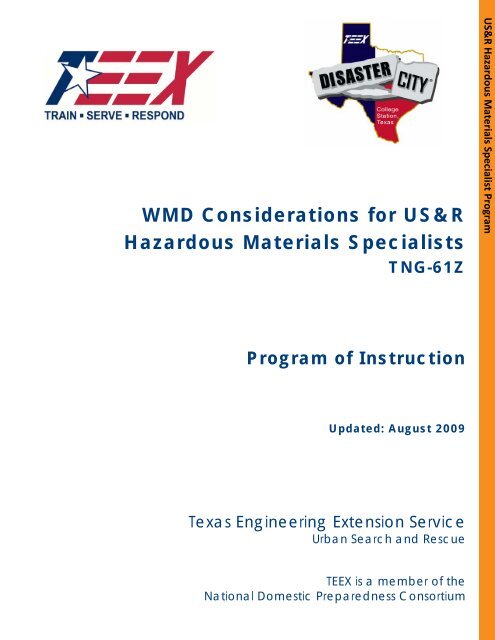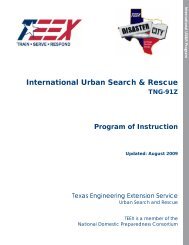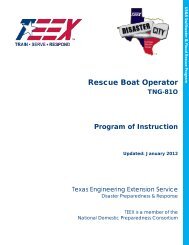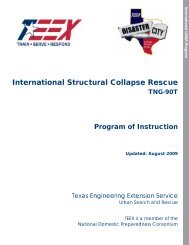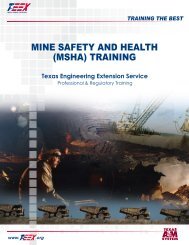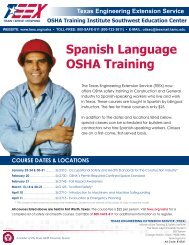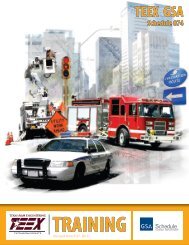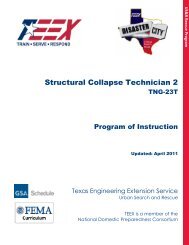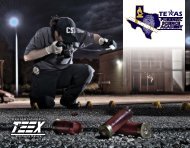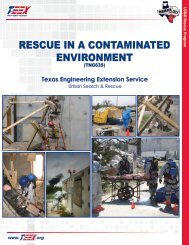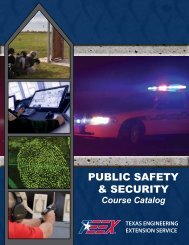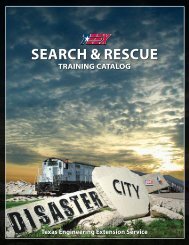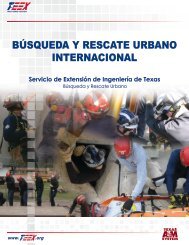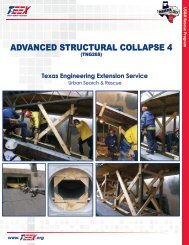WMD Considerations for US&R Hazardous Materials Specialists
WMD Considerations for US&R Hazardous Materials Specialists
WMD Considerations for US&R Hazardous Materials Specialists
Create successful ePaper yourself
Turn your PDF publications into a flip-book with our unique Google optimized e-Paper software.
<strong>WMD</strong> <strong>Considerations</strong> <strong>for</strong> US&R<br />
<strong>Hazardous</strong> <strong>Materials</strong> <strong>Specialists</strong><br />
TNG-61Z<br />
US&R <strong>Hazardous</strong> <strong>Materials</strong> Specialist Program<br />
Program of Instruction<br />
Updated: August 2009<br />
Texas Engineering Extension Service<br />
Urban Search and Rescue<br />
TEEX is a member of the<br />
National Domestic Preparedness Consortium
<strong>WMD</strong> <strong>Considerations</strong> <strong>for</strong> US&R HazMat <strong>Specialists</strong> – Program of Instruction<br />
Course Details<br />
Course Length: One day long, approximately eight hours if training each day. Class is from<br />
0800 to 1700.<br />
D elivery Location: Delivered in Disaster City® , TX – within the city limits of College Station,<br />
TX or equivalent training facility.<br />
Certificate: TEEX certificate of completion<br />
Prerequisites: Prior to attending this course, participants must:<br />
• Complete a <strong>Hazardous</strong> <strong>Materials</strong> Technician (HAZ020) course or equivalent<br />
Target Audience:<br />
US&R <strong>Hazardous</strong> <strong>Materials</strong> Specialist Program<br />
This course has been developed <strong>for</strong> city, state and federal urban search and responders. The target<br />
audience also includes all emergency responders from municipal and industrial agencies tasked<br />
with per<strong>for</strong>ming medical duties at a US&R or terrorist incident. Course participants include<br />
emergency responders from the following five disciplines/services:<br />
• Fire Service (FS)<br />
• <strong>Hazardous</strong> <strong>Materials</strong> (HazMat)<br />
• Emergency Medical Services (EMS)<br />
• Law En<strong>for</strong>cement (LE)<br />
• Military (MT)<br />
• Civil Defense (CD)<br />
Mission Area: Respond<br />
Level of Training: Per<strong>for</strong>mance – Offensive<br />
Required Equipment:<br />
This course requires students to bring with them specific equipment. The course participants<br />
should arrive with the following items:<br />
• Helmet (must be ANSI rated Z89.1 – Type 1) with headlamp<br />
• Steel toe safety boots (must be ANSI Z41 PT99 M1/75 C/75)<br />
Page 2 of 19
<strong>WMD</strong> <strong>Considerations</strong> <strong>for</strong> US&R HazMat <strong>Specialists</strong> – Program of Instruction<br />
Course Overview<br />
Course Background<br />
The <strong>WMD</strong> <strong>Considerations</strong> <strong>for</strong> US&R <strong>Hazardous</strong> <strong>Materials</strong> <strong>Specialists</strong> course is designed to be<br />
taken by every <strong>Hazardous</strong> <strong>Materials</strong> Specialist on a state or regional task <strong>for</strong>ce that will respond to<br />
possible <strong>WMD</strong> or CBNRE incidents. This course mirrors the <strong>WMD</strong> <strong>Considerations</strong> <strong>for</strong> <strong>Hazardous</strong><br />
<strong>Materials</strong> <strong>Specialists</strong> course taught to every <strong>Hazardous</strong> <strong>Materials</strong> Specialist on a FEMA National<br />
US&R Task Force. This course is designed to ensure that all task <strong>for</strong>ce hazardous materials team<br />
members have a common base level of knowledge concerning <strong>WMD</strong> and CBRNE operations in a<br />
US&R environment.<br />
Course Description<br />
This course is designed to provide students with the knowledge, skills, and abilities to support<br />
operations in a <strong>WMD</strong> or hazardous materials environment due to a terrorist incident. This course<br />
provides the participants with the understanding of the unique considerations of a <strong>WMD</strong><br />
environment and how to identify and assist when per<strong>for</strong>ming rescues in a contaminated<br />
environment.<br />
US&R <strong>Hazardous</strong> <strong>Materials</strong> Specialist Program<br />
Course Purpose<br />
The purpose of this course is to provide additional advanced education to a certified <strong>Hazardous</strong><br />
<strong>Materials</strong> Technician so that they can fill the position of US&R <strong>Hazardous</strong> <strong>Materials</strong> Specialist on<br />
a US&R Task Force. The US&R <strong>Hazardous</strong> <strong>Materials</strong> Specialist supports the search teams and<br />
rescue teams when conducting operations in known or suspected <strong>WMD</strong> or hazardous environment.<br />
The US&R <strong>Hazardous</strong> <strong>Materials</strong> Specialist determines appropriate personnel protective equipment<br />
and provides team members with monitoring, detection, and sampling capabilities. Participants in<br />
this course will review the chemical and physiological properties of possible agents, as well as the<br />
characteristics of biological and radioactive material.<br />
Course Format<br />
Classes will begin at 8:00 a.m. Participants should plan travel to arrive the night be<strong>for</strong>e classes<br />
begin. For the purpose of making hotel arrangements, participants could make reservations in the<br />
cities of Bryan, TX or College Station, TX. Course delivery consists of didactic instruction,<br />
participant activities, and hands-on task-oriented practical exercises. Course delivery consists of 85<br />
percent didactic classroom presentations and lectures, and 15 percent group activities.<br />
Students can attend the <strong>WMD</strong> <strong>Considerations</strong> <strong>for</strong> US&R <strong>Hazardous</strong> <strong>Materials</strong> <strong>Specialists</strong> course in<br />
two <strong>for</strong>mats:<br />
1. Open enrollment classes – TEEX offers the course on fixed dates approximately three<br />
times per. Any student meeting the prerequisites may enroll in the course online. This<br />
course typically has a broad cross section of responders and offers an excellent ability<br />
<strong>for</strong> lessons learned from other departments.<br />
2. Contract classes – TEEX can provide this course exclusively <strong>for</strong> a jurisdiction or<br />
region. These courses must have a minimum of 16 and can have a maximum of 32<br />
participants. When conducting contract classes, TEEX can add curriculum to meet<br />
specific requirements of the sponsoring jurisdiction.<br />
Page 3 of 19
Course Scope<br />
<strong>WMD</strong> <strong>Considerations</strong> <strong>for</strong> US&R HazMat <strong>Specialists</strong> – Program of Instruction<br />
The scope of this course addresses priorities and capabilities that Department of Homeland<br />
Security is encouraging state and local jurisdictions to establish. This course assists with<br />
establishing priorities <strong>for</strong> the National Planning Scenarios 1 , the National Preparedness Guidelines 2 ,<br />
the Target Capabilities List 3 , and the Universal Task List 4 .<br />
National Planning Scenarios<br />
The National Planning Scenarios 1 are a reference to help federal, state, local, and tribal entities at<br />
all levels of government evaluate and improve their capabilities to per<strong>for</strong>m their assigned missions<br />
and tasks in major events. This course gives a state/region the capability to conduct wide area<br />
search operations in twelve out of the fifteen National Planning Scenarios 1 :<br />
Scenario 1: Nuclear Detonation – 10-Kiloton Improvised Nuclear Device<br />
Scenario 2: Biological Attack – Aerosol Anthrax<br />
Scenario 3: Biological Disease Outbreak – Pandemic Influenza<br />
Scenario 4: Biological Attack – Plague<br />
Scenario 5: Chemical Attack – Blister Agent<br />
Scenario 6: Chemical Attack – Toxic Industrial Chemicals<br />
Scenario 7: Chemical Attack – Nerve Agent<br />
Scenario 8: Chemical Attack – Chlorine Tank Explosion<br />
Scenario 9: Natural Disaster – Major Earthquake<br />
Scenario 10: Natural Disaster – Major Hurricane<br />
Scenario 11: Radiological Attack – Radiological Dispersal Devices<br />
Scenario 12: Explosives Attack – Bombing Using Improvised Explosive Devices<br />
US&R <strong>Hazardous</strong> <strong>Materials</strong> Specialist Program<br />
National Preparedness Guidelines<br />
The National Preparedness Guidelines 2 defines what it means <strong>for</strong> the Nation to be prepared <strong>for</strong> all<br />
hazards. There are four critical elements of the Guidelines:<br />
(1) The National Preparedness Vision, which provides a concise statement of the core<br />
preparedness goal <strong>for</strong> the Nation.<br />
(2) The National Planning Scenarios 1 , which depict a diverse set of high consequence<br />
threat scenarios of both potential terrorist attacks and natural disasters. Collectively, the<br />
15 scenarios are designed to focus contingency planning <strong>for</strong> homeland security<br />
preparedness work at all levels of government and with private sector. The scenarios<br />
<strong>for</strong>m the basis <strong>for</strong> national planning, training, exercises, and grant investments needed<br />
to prepare <strong>for</strong> emergencies of all types.<br />
(3) The Target Capabilities List 3 (TCL), which defines 37 specific capabilities that<br />
communities, the private sector, and all levels of government should collectively<br />
possess in order to respond effectively to disasters.<br />
(4) The Universal Task List 4 (UTL), which is a menu of some 1,600 unique tasks that can<br />
facilitate ef<strong>for</strong>ts to prevent, protect against, respond to, and recover from the major<br />
events that are represented by the National Planning Scenarios. It presents a common<br />
vocabulary and identifies key tasks that support development of essential capabilities<br />
among organizations at all levels.<br />
Page 4 of 19
<strong>WMD</strong> <strong>Considerations</strong> <strong>for</strong> US&R HazMat <strong>Specialists</strong> – Program of Instruction<br />
Course Scope (continued)<br />
The Guidelines establish a capabilities-based approach to preparedness. Simply put, a capability<br />
provides the means to accomplish a mission. The Guidelines address preparedness <strong>for</strong> all homeland<br />
security mission areas: prevention, protection, response, and recovery. A capability consists of the<br />
combination of elements required to deliver the desired outcome.<br />
TEEX US&R courses primarily deal with the Search and Rescue (Land-Based) capabilities found<br />
within the Respond Mission Area and the outcome is: The greatest number of victims (human and,<br />
to the extent that no human remain endangered, animal) are rescued and transferred to medical or<br />
mass care capabilities, in the shortest amount of time, while maintaining rescuer safety.<br />
In order to support a consistent nationwide approach to implementation, the Guidelines establish<br />
three capabilities-based preparedness tools and a National Preparedness System. To help correctly<br />
balance the potential threat of major events with the requisite resources to prevent, respond to, and<br />
recover from them, the Guidelines also includes seven national priorities. The priorities fall into<br />
two categories: overarching priorities that contribute to development of multiple capabilities, and<br />
capability-specific priorities that build selected capabilities from the TCL <strong>for</strong> which the Nation has<br />
the greatest need. Priorities that apply to this course are highlighted in red. The overarching<br />
priorities are:<br />
US&R <strong>Hazardous</strong> <strong>Materials</strong> Specialist Program<br />
4.1 Expand Regional Collaboration<br />
4.2 Implement the NIMS 6 & the National Response Framework 5<br />
4.3 Implement the National Infrastructure Protection Plan<br />
Additionally, the National Preparedness Guidelines 2 has four capability specific priorities:<br />
4.4 Strengthen In<strong>for</strong>mation Sharing and Collaboration Capabilities<br />
4.5 Strengthen Interoperable and Operable Communications Capabilities<br />
4.6 Strengthen CBRNE Detection, Response, and Decontamination Capabilities – this<br />
course specifically addresses this National Preparedness Goal priority<br />
4.7 Strengthen Medical Surge and Mass Prophylaxis Capabilities<br />
Page 5 of 19
<strong>WMD</strong> <strong>Considerations</strong> <strong>for</strong> US&R HazMat <strong>Specialists</strong> – Program of Instruction<br />
Course Scope (continued)<br />
Target Capabilities List<br />
The September 2007 version of the Target Capabilities List 3 (TCL) provides guidance on the<br />
specific capabilities and levels of capability that Federal, State, local, and tribal entities will be<br />
expected to develop and maintain. The TCL is designed to assist jurisdictions and agencies in<br />
understanding and defining their respective roles in a major event, the capabilities required to<br />
per<strong>for</strong>m a specific set of tasks, and where to obtain additional resources if needed. The TCL is<br />
considered a “living” document that will continue to be refined over time. The TCL identifies 37<br />
essential capabilities. The applicable tables of the Response Mission: Search and Rescue (Land-<br />
Based) – Target Capabilities (page 407 thru 419 of the September 2007 TCL) that deal with Search<br />
and Rescue are included below. Personnel having completed the <strong>WMD</strong> <strong>Considerations</strong> <strong>for</strong> US&R<br />
HazMat <strong>Specialists</strong> course give jurisdictions the capabilities that are highlighted in red.<br />
Capability Definition<br />
US&R <strong>Hazardous</strong> <strong>Materials</strong> Specialist Program<br />
Search & Rescue (Land-Based) is the capability to coordinate and conduct search and rescue<br />
(SAR) response ef<strong>for</strong>ts <strong>for</strong> all hazards, including searching affected areas <strong>for</strong> victims (human and,<br />
to the extent that no humans remain endangered, animal) and locating, accessing, medically<br />
stabilizing, and extricating victims from the damaged area.<br />
Outcome<br />
The greatest number of victims (human, and to the extent that no humans remain endangered,<br />
animal) and rescued and transferred to medical or mass care capabilities, in the shortest amount of<br />
time, while maintaining rescuer safety.<br />
Per<strong>for</strong>mance Measures and Metrics and Critical Tasks<br />
Activity: Direct Search & Rescue Tactical Operations<br />
Definition: In response to notification of entrapment, provide management and coordination of<br />
SAR capability, through demobilization <strong>for</strong> single or multiple teams<br />
Critical Tasks<br />
Res.B4a 3.1 Receive and accept SAR request/activation order<br />
Res.B4a 3.2 Participate in SAR planning process and operational briefings<br />
Res.B4a 3 Plan and coordinate SAR operations at incident site<br />
Res.B4a 3.4.1<br />
Direct SAR resources according to the National Incident Management System (NIMS), the<br />
Incident Command System (ICS), and consensus-level technical rescue standards<br />
Res.B4a 3.4.3 Determine need <strong>for</strong> deployment of additional SAR assets<br />
Res.B4a 3.6.1 Provide timely situational awareness and response in<strong>for</strong>mation<br />
Res.B4a 3.6.1.1 Establish and maintain a chronological log of events in the field<br />
Res.B4a 3.6.2<br />
Document and collect SAR operations in<strong>for</strong>mation, including chronological log of events in the<br />
field <strong>for</strong> use in after action review<br />
Res.B4a 3.7.3 Re-assign/rotate technical specialists, as needed<br />
Res.B4a 3.3.3 Maintain accountability of all SAR personnel<br />
Res.B4a 3.2.1<br />
Identify logistics capability of incident site to determine whether deployed SAR teams must be<br />
self-sustaining<br />
Res.B4a 3.7 Develop SAR team reassignment/demobilization plan<br />
Page 6 of 19
<strong>WMD</strong> <strong>Considerations</strong> <strong>for</strong> US&R HazMat <strong>Specialists</strong> – Program of Instruction<br />
Course Scope (continued)<br />
Target Capabilities List (continued)<br />
Activity: Activate Search & Rescue<br />
Definition: In response to notification, mobilize and arrive at the incident scene to begin<br />
operations<br />
Critical Tasks<br />
Res.B4a 3.1 Receive and accept SAR request/activation order<br />
Res.B4a 4.3 Participate in Search and Rescue (SAR) planning process and operational briefings<br />
Res.B4a 4.2 Initiate mobilization procedure<br />
Res.B4a 4.2.1 Assemble personnel and equipment at designated location<br />
Res.B4a 4.2.2 Deploy Federal, State, regional or local SAR resources commensurate with request<br />
Res.B4a 4.2.2 Transport team (personnel and equipment) to incident scene<br />
Res.B4a 4.2.3 Collect and analyze incident in<strong>for</strong>mation to assist SAR capability deployment decisions<br />
US&R <strong>Hazardous</strong> <strong>Materials</strong> Specialist Program<br />
Activity: Provide Materiel and Other Support<br />
Definition: Upon arriving on scene, provide, track, and maintain equipment and supplies as well as<br />
support base of operations<br />
Critical Tasks<br />
Res.B4a 4.3 Participate in Search and Rescue (SAR) planning process and operational briefings<br />
Res.B4a 5.1 Establish base of operations<br />
Res.B4a 5.2 Maintain accountability of team equipment/supplies<br />
Res.B4a 5.1.1 Provide medical care <strong>for</strong> SAR personnel, including the K-9 first responders<br />
Activity: Conduct Search and Rescue Reconnaissance<br />
Definition: Once on scene and equipped, provide rapid assessment of assigned SAR work areas<br />
and recommend search priorities/tactics to management.<br />
Critical Tasks<br />
Res.B4a 6.1.1 Assess incident site to determine search and rescue course of action<br />
Res.B4a 6.1.2 Assess the incident site <strong>for</strong> hazardous materials (hazmat) and other environmental conditions<br />
Res.B4a 6.1.3 Develop map of search area to be used in SAR tactical operations<br />
Res.B4a 6.3 Communicate findings and recommend priorities to Team Management<br />
Activity: Search<br />
Definition: Upon being assigned search area, begins search operations.<br />
Critical Tasks<br />
Res.B4a 4.3 Participate in SAR planning process and operational briefings<br />
Res.B4a 7.1 Ensure scene/site safety (security, shoring, debris)<br />
Res.B4a 7.2 Conduct area search <strong>for</strong> victims<br />
Res.B4a 7.2.1 Search <strong>for</strong> victims using canine, physical, and electronic search capabilities<br />
Res.B4a 7.2.2 Identify and record potential/actual victim locations (live and dead)<br />
Res.B4a 7.3 Direct ambulatory victims to safe assembly point<br />
Res.B4a 7.4 Report progress of search ef<strong>for</strong>ts on a regular basis to SAR lead<br />
Res.B4a 7.5 Maintain accountability <strong>for</strong> search personnel, equipment, and supplies<br />
Page 7 of 19
<strong>WMD</strong> <strong>Considerations</strong> <strong>for</strong> US&R HazMat <strong>Specialists</strong> – Program of Instruction<br />
Course Scope (continued)<br />
Target Capabilities List (continued)<br />
Activity: Extricate<br />
Definition: Upon notification of location of victim, per<strong>for</strong>m extrication.<br />
Critical Tasks<br />
Res.B4a 4.3 Participate in SAR planning process and operational briefings<br />
Res.B4a 7.1 Ensure scene/site safety (security, shoring, debris)<br />
Res.B4a 8.1.1 Coordinate extrication strategy with medical personnel<br />
Res.B4a 8.1 Extricate trapped victims<br />
Res.B4a 8.2 Provide periodic progress reports while rescuing<br />
Res.B4a 8.3 Maintain accountability of extrication personnel, equipment, and supplies<br />
Activity: Provide Medical Treatment<br />
US&R <strong>Hazardous</strong> <strong>Materials</strong> Specialist Program<br />
Definition: Upon access to victim, coordinate with medical personnel to treat and transfer victim<br />
to more definitive medical care.<br />
Critical Tasks<br />
Res.B4a 4.3 Participate in US&R planning process and operational briefings<br />
Res.B4a 9.1.1 Coordinate medical treatment with extrication and medical personnel<br />
Res.B4a 9.2 Transfer victims to more definitive medical care<br />
Res.B4a 9.1.2<br />
Medically stabilize trapped victims according to Task Force Operations Manual and Medical<br />
Protocols<br />
Res.B4a 9.1.2.1<br />
Ensure victims are medically stabilized according to Task Force Operations Manual and Medical<br />
Protocols throughout packaging and extrication<br />
Res.B4a 9.3 Maintain accountability of medical personnel, equipment, and supplies<br />
Activity: Demobilize/Redeploy<br />
Definition: Upon completion of assigned mission, disengage from incident site, and debrief<br />
personnel<br />
Critical Tasks<br />
Res.B4a 10.2.1 Repackage equipment cache<br />
Res.B4a 10.2 Demobilize base of operations<br />
Res.B4a 10.1.1 Arrange transportation <strong>for</strong> personnel and equipment<br />
Res.B4a 10.1.2 Debrief SAR capability personnel<br />
Page 8 of 19
<strong>WMD</strong> <strong>Considerations</strong> <strong>for</strong> US&R HazMat <strong>Specialists</strong> – Program of Instruction<br />
Course Scope (continued)<br />
Universal Task List<br />
The Universal Task List 4 (UTL) is a useful planning reference: a comprehensive menu of tasks that<br />
may be per<strong>for</strong>med in major events illustrated by the National Planning Scenarios 1 . The UTL<br />
describes “what” tasks need to be per<strong>for</strong>med. Federal, state, local and tribal entities reserve the<br />
flexibility to determine “who” needs to per<strong>for</strong>m them and “how” to per<strong>for</strong>m them. While no single<br />
jurisdiction or agency is expected to be able to per<strong>for</strong>m all the tasks, it is expected that tasks will be<br />
chosen based on specific roles, missions, and functions. The UTL should be used by entities at all<br />
levels of government as a reference to help them plan, organize, equip, train, exercise, and evaluate<br />
personnel from the critical tasks that they may need to per<strong>for</strong>m in major events that could occur<br />
across town or across the Nation. The UTL is considered a “living” document that will continue to<br />
be refined over time. The applicable tables of the UTL (pages 82 thru 83 of the Version 2.1 issued<br />
May 23, 2005) that deal with Search and Rescue are included below. Jurisdictions with personnel<br />
that have completed the <strong>WMD</strong> <strong>Considerations</strong> <strong>for</strong> US&R HazMat <strong>Specialists</strong> course will have the<br />
capacity to per<strong>for</strong>m the following tasks outlined in red:<br />
US&R <strong>Hazardous</strong> <strong>Materials</strong> Specialist Program<br />
Function Sequence<br />
ID<br />
Number<br />
Task<br />
Res.B.4 1 Develop plans, procedures, and protocols to prepare <strong>for</strong> urban search and rescue<br />
operations<br />
Res.B.4 1.1 Develop policies and procedures <strong>for</strong> urban search and rescue<br />
Res.B.4 1.2 Establish, maintain, and manage the national urban search and rescue response system<br />
Res.B.4 1.3 Ensure appropriate legal issues pertaining to liability claims, including the application<br />
of the good Samaritan laws, are understood and resolved<br />
Res.B.4 1.4 Establish plans, procedures and protocols <strong>for</strong> logistical support <strong>for</strong> urban search and<br />
rescue assets<br />
Res.B.4 2 Develop and conduct exercises and training <strong>for</strong> search and rescue<br />
Res.B.4 2.1 Develop urban search and rescue training programs<br />
Res.B.4 2.2 Provide training <strong>for</strong> urban search and rescue augmenting organizations<br />
Res.B.4 3 Coordinate urban search and rescue response<br />
Res.B.4 3.1 Provide resource & technical support<br />
Res.B.4 3.1.1 Manage urban search and rescue mutual aid agreements<br />
Res.B.4 3.1.2 Provide technical assistance, training, and operational support to urban search and<br />
rescue teams and assets<br />
Res.B.4 3.1.2.1 Provide portable shelters <strong>for</strong> use by urban search and rescue task <strong>for</strong>ce<br />
Res.B.4 3.1.2.2 Provide mobile feeding units <strong>for</strong> urban search and rescue task <strong>for</strong>ce<br />
Res.B.4 3.1.3 Identify need <strong>for</strong> additional assistance<br />
Res.B.4 4 Conduct Search and Rescue<br />
Res.B.4 4.1 Assess situation and needs<br />
Res.B.4 4.2 Assess incident site to determine search and rescue course of action<br />
Res.B.4 4.2.1 Collect assessment in<strong>for</strong>mation from damage assessment teams <strong>for</strong><br />
inclusion in situation reports and <strong>for</strong> decision-making regarding<br />
US&R resources<br />
Res.B.4 4.2.2 Issue additional advisories and alert and activation orders as required<br />
Res.B.4 4.2.3 Determine need <strong>for</strong> deployment of additional US&R assets<br />
Res.B.4 4.3 Conduct urban search and rescue operations<br />
Res.B.4 4.3.1 Activate urban search and rescue support (US&R)<br />
Res.B.4 4.3.1.1 Activate the national urban search and rescue response system <strong>for</strong> any incident of<br />
national significance<br />
Page 9 of 19
<strong>WMD</strong> <strong>Considerations</strong> <strong>for</strong> US&R HazMat <strong>Specialists</strong> – Program of Instruction<br />
Course Scope (continued)<br />
Universal Task List (continued)<br />
Function Sequence<br />
ID<br />
Number<br />
Task<br />
Res.B.4 4.3.2 Deploy urban search and rescue task <strong>for</strong>ces or teams<br />
Res.B.4 4.3.3 Evaluate the disaster site <strong>for</strong> hazardous materials<br />
Res.B.4 4.3.3.1 Identify heavy machinery support requirements<br />
Res.B.4 4.3.4 Direct search and rescue teams and collapse-site teams<br />
Res.B.4 4.3.5 Search and extract victims from site<br />
Res.B.4 4.3.5.1 Direct the use of heavy machinery in recovery ef<strong>for</strong>t<br />
Res.B.4 4.3.5.2 Stabilize and support entry and exit points <strong>for</strong> urban search and rescue operations<br />
Res.B.4 4.3.6 Provide status reports on urban search and rescue operations<br />
Res.B.4 4.3.6.1 Provide timely situational awareness and response in<strong>for</strong>mation and establish and<br />
maintain chronological log of events in the field<br />
Res.B.4 4.3.7 Formulate redeployment plans <strong>for</strong> urban search and rescue assets and personnel<br />
Res.B.4 4.3.7.1 Formulate decisions on the demobilization of regional and State first responder assets<br />
and personnel<br />
Res.B.4 4.3.8 Provide care <strong>for</strong> rescuers, including the K-9 first responders<br />
US&R <strong>Hazardous</strong> <strong>Materials</strong> Specialist Program<br />
Page 10 of 19
<strong>WMD</strong> <strong>Considerations</strong> <strong>for</strong> US&R HazMat <strong>Specialists</strong> – Program of Instruction<br />
Course Scope (continued)<br />
Additional Courses<br />
TEEX US&R can provide additional courses related to search and rescue at Disaster City® or onsite<br />
at your jurisdiction:<br />
US&R <strong>Hazardous</strong> <strong>Materials</strong> Specialist Program:<br />
1. <strong>WMD</strong> – Enhanced US&R Operations<br />
2. <strong>WMD</strong> <strong>Considerations</strong> <strong>for</strong> US&R <strong>Hazardous</strong> <strong>Materials</strong> <strong>Specialists</strong><br />
US&R Search Program:<br />
1. Disaster Technical Search Specialist<br />
2. Disaster Canine Search Specialist<br />
3. Disaster Canine Workshop<br />
4. Wilderness Search and Rescue<br />
5. Wide Area Search NOTE: offered at no cost to any eligible jurisdiction<br />
6. Canine Emergency Medical Care NOTE: offered online at no cost to any eligible participant<br />
US&R Rescue Program:<br />
1. Structural Collapse - Awareness<br />
2. Collapse Rescue Operations<br />
3. Structural Collapse Technician 2<br />
4. Advanced Structural Collapse 3<br />
5. Advanced Structural Collapse 4<br />
6. Medical <strong>Considerations</strong> <strong>for</strong> the Rescue Technician<br />
7. Rescue in a Contaminated Environment (RICE)<br />
Swift Water & Flood Rescue Program:<br />
1. Swift Water Rescue – Awareness<br />
2. Swift Water Rescue – Operations<br />
3. Swift Water Rescue – Technician<br />
4. Swift Water Rescue – Technician Refresher<br />
US&R Medical Program:<br />
1. Disaster Medical Specialist<br />
2. <strong>WMD</strong> <strong>Considerations</strong> <strong>for</strong> the Medical Specialist<br />
3. Medical Effects of Primary Blast Injuries NOTE: offered online at no cost to any eligible participant<br />
4. EMS Operations & Planning <strong>for</strong> <strong>WMD</strong> NOTE: offered at no cost to any eligible jurisdiction<br />
US&R Command Staff Program:<br />
1. Search and Rescue Plans Officer<br />
2. Search and Rescue Safety Officer<br />
3. Search and Rescue Communications Specialist<br />
4. Disaster Logistics Specialist<br />
5. ICS <strong>for</strong> Structural Collapse Incidents<br />
6. Developing a State/Regional CBRNE Task Force<br />
International US&R Program:<br />
1. International Urban Search and Rescue<br />
2. International Structural Collapse Rescue<br />
US&R Full-Scale Exercise Program<br />
US&R <strong>Hazardous</strong> <strong>Materials</strong> Specialist Program<br />
Page 11 of 19
<strong>WMD</strong> <strong>Considerations</strong> <strong>for</strong> US&R HazMat <strong>Specialists</strong> – Program of Instruction<br />
Course Scope (continued)<br />
Resource Requirements<br />
The following items are provided by TEEX <strong>for</strong> the delivery of this course:<br />
• Classroom capable of handling all course participants<br />
• Computer loaded with Microsoft PowerPoint®<br />
• Computer Projector and screen<br />
• Flip chart and/or whiteboard or chalkboard<br />
• Flip chart markers and/or whiteboard markers or chalk<br />
• Student Manual<br />
• Instructor Manuals<br />
• Module 1 – 4 Microsoft PowerPoint® presentation slides<br />
• All tools, equipment, and supplies required to complete field exercises<br />
• All patient simulators and live victims.<br />
US&R <strong>Hazardous</strong> <strong>Materials</strong> Specialist Program<br />
Page 12 of 19
Unit Summary<br />
<strong>WMD</strong> <strong>Considerations</strong> <strong>for</strong> US&R HazMat <strong>Specialists</strong> – Program of Instruction<br />
Module #<br />
Module Title<br />
Time<br />
Allocation<br />
Day One<br />
Module 0 Welcome and Introductions 10 minutes<br />
Module 1 Chemical and Physical Properties 1 hr 15 min<br />
Module 2 Protection 1 hr 45 min<br />
Admin 0.1 Lunch 1 hour<br />
Module 3 Monitoring / Detection / Sampling 3 hrs 15 min<br />
Module 4 Tactical <strong>Considerations</strong> 1 hr 30 min<br />
Course Summary, End of Course Test, and Evaluation 15 minutes<br />
TOTAL CLASS HOURS<br />
8 hours<br />
¹ Students build on skills throughout the training, demonstrating each skill be<strong>for</strong>e progressing. Students end<br />
the course with a final written exam testing their knowledge.<br />
US&R <strong>Hazardous</strong> <strong>Materials</strong> Specialist Program<br />
Page 13 of 19
<strong>WMD</strong> <strong>Considerations</strong> <strong>for</strong> US&R HazMat <strong>Specialists</strong> – Program of Instruction<br />
Module 0: Welcome and Introductions<br />
Summary: The participants will become familiar with the general overview of the course, and<br />
instructors will explain the goal of the course, and describe the course outline and structure.<br />
Students will also complete all registration and class rosters <strong>for</strong>ms.<br />
Instructional Resources Required:<br />
• Module 0 presentation slides<br />
• Participant Manual<br />
• Computer<br />
• Projector<br />
Terminal Learning Objective: Upon the completion of this course, participants posses the<br />
knowledge, skills and, abilities to per<strong>for</strong>m the function of a US&R <strong>Hazardous</strong> <strong>Materials</strong> Specialist<br />
deploying and operating with a US&R task <strong>for</strong>ce in a <strong>WMD</strong> (CBNRE) environment.<br />
US&R <strong>Hazardous</strong> <strong>Materials</strong> Specialist Program<br />
Enabling Objectives: Upon the conclusion of this course, participants will be able to:<br />
0-1 Understand the chemical and physical properties of potential <strong>WMD</strong> agents;<br />
0-2 Understand the proper protection in a <strong>WMD</strong> environment when working as a member<br />
of the US&R <strong>Hazardous</strong> <strong>Materials</strong> team;<br />
0-3 Understand the requirements of monitoring, detection, and sampling in a <strong>WMD</strong><br />
environment; and<br />
0-4 Demonstrate and understanding of the tactical considerations of a US&R <strong>Hazardous</strong><br />
<strong>Materials</strong> Specialist conducting operations in known or suspected <strong>WMD</strong> or hazardous<br />
environment.<br />
Duration: 10 minutes<br />
Method of Instruction: Facilitated seminar <strong>for</strong>mat in a classroom environment<br />
Instructor Ratio: 1:15<br />
Required Reading: None<br />
Special Instructions: None<br />
Page 14 of 19
<strong>WMD</strong> <strong>Considerations</strong> <strong>for</strong> US&R HazMat <strong>Specialists</strong> – Program of Instruction<br />
Module 1: Chemical and Physical Properties<br />
Summary: This module discusses the overall chemical and physical properties of chemical,<br />
biological and radiological agents that may be used as a <strong>WMD</strong>. The module discusses toxicity and<br />
classes of chemical agents. The module concludes with a risk based response exercise.<br />
Instructional Resources Required:<br />
• Module 1 presentation slides<br />
• Participant Manual<br />
• Computer<br />
• Projector<br />
Terminal Learning Objective: Upon the successful completion of this module, participants will<br />
be able to describe the hazard characteristics to themselves and other task <strong>for</strong>ce members when<br />
working in a contaminated environment.<br />
Enabling Objective: Upon conclusion of the module, participants will be able to:<br />
US&R <strong>Hazardous</strong> <strong>Materials</strong> Specialist Program<br />
1-1 Describe the chemical properties of potential <strong>WMD</strong> agents;<br />
1-2 Describe the physiological properties of potential <strong>WMD</strong> agents;<br />
1-3 Describe the classes of chemical agents;<br />
1-4 Describe and compare the toxicity of chemical agents<br />
1-5 Describe the characteristics of biological agents<br />
1-6 Describe the characteristics of radioactive materials; and<br />
1-7 Apply the lessons learned in this module to conduct a Risk Based Response<br />
Exercise.<br />
Duration: 1 hour 15 minutes<br />
Method of Instruction: Facilitated seminar <strong>for</strong>mat in a classroom environment<br />
Instructor Ratio: 1:15<br />
Required Reading: None<br />
Special Instructions: None<br />
Page 15 of 19
<strong>WMD</strong> <strong>Considerations</strong> <strong>for</strong> US&R HazMat <strong>Specialists</strong> – Program of Instruction<br />
Module 2: Protection<br />
Summary: This module provides an overview the selection criteria <strong>for</strong> proper protective<br />
equipment <strong>for</strong> a US&R task <strong>for</strong>ce operating in a <strong>WMD</strong> or CBRNE environment. This module<br />
provides participants with the knowledge and in<strong>for</strong>mation needed to select the appropriate level of<br />
protection <strong>for</strong> the agent involved.<br />
Instructional Resources Required:<br />
• Module 2 presentation slides<br />
• Participant Manual<br />
• Computer<br />
• Projector<br />
Terminal Learning Objective: Upon the successful completion of this module, participants will<br />
be able to select appropriate Personal Protective Equipment (PPE) based on the chemical and<br />
physical properties of the agent and the work environment and conditions.<br />
US&R <strong>Hazardous</strong> <strong>Materials</strong> Specialist Program<br />
Enabling Objective: Upon conclusion of the module, participants will be able to:<br />
2-1 Describe the importance of respiratory protection;<br />
2-2 Describe the types of respiratory protection;<br />
2-3 Describe the types chemical personal protective clothing (CPC);<br />
2-4 Describe agent-specific respiratory protection and chemical protective clothing; and<br />
2-5 Apply the lessons learned in this module to a PPE selecting activity.<br />
Duration: 1 hour 45 minutes<br />
Method of Instruction: Facilitated seminar <strong>for</strong>mat in a classroom environment<br />
Instructor Ratio: 1:15<br />
Required Reading: None<br />
Special Instructions: None<br />
Page 16 of 19
<strong>WMD</strong> <strong>Considerations</strong> <strong>for</strong> US&R HazMat <strong>Specialists</strong> – Program of Instruction<br />
Module 3: Monitoring / Detection / Sampling<br />
Summary: This module discusses the various detection methods used to confirm that an agent is<br />
present and help determine the protection level, first aid, and decontamination measures necessary.<br />
This module will familiarize the participants with the various types of fielded detection methods<br />
available, which may prove to be useful when responding to an incident involving dangerous<br />
agents.<br />
Instructional Resources Required:<br />
• Module 3 presentation slides<br />
• Participant Manual<br />
• Computer<br />
• Projector<br />
Terminal Learning Objective: Upon the successful completion of this module, participants will<br />
be able to identify monitoring devices and equipment likely to be useful in a response to terrorist<br />
incident.<br />
US&R <strong>Hazardous</strong> <strong>Materials</strong> Specialist Program<br />
Enabling Objective: Upon the conclusion of this module, participants will be able to:<br />
3-1 Describe the methods of monitoring, detection, and sampling;<br />
3-2 Describe strategies <strong>for</strong> detection, monitoring, and sampling <strong>for</strong> terrorism agents; and<br />
3-3 Apply the lessons learned in this module to utilize various monitoring and detection<br />
equipment to detect various hazards.<br />
Duration: 3 hours 15 minutes<br />
Method of Instruction: Facilitated seminar <strong>for</strong>mat in a classroom environment<br />
Instructor Ratio: 1:15<br />
Required Reading: None<br />
Special Instructions: None<br />
Page 17 of 19
<strong>WMD</strong> <strong>Considerations</strong> <strong>for</strong> US&R HazMat <strong>Specialists</strong> – Program of Instruction<br />
Module 4: Tactical <strong>Considerations</strong><br />
Summary: This module provides an overview of the strategies <strong>for</strong> responding to acts of terrorism<br />
as well as the strategies themselves. This module will introduce tactical options available to<br />
effectively respond to such acts. This module discusses how responding to terrorist incidents can<br />
be significantly different from responding to traditional incidents.<br />
Instructional Resources Required:<br />
• Module 4 presentation slides<br />
• Participant Manual<br />
• Computer<br />
• Projector<br />
Terminal Learning Objective: Upon the completion of this module, participants will be able to<br />
explain how a specific response strategy <strong>for</strong> a given scenario and proposed tactical options will<br />
increase responder survivability and response effectiveness.<br />
US&R <strong>Hazardous</strong> <strong>Materials</strong> Specialist Program<br />
Enabling Objective: At the conclusion of this module, the participants will be able to:<br />
4-1 Describe the procedures <strong>for</strong> gathering in<strong>for</strong>mation;<br />
4-2 Understand how to estimate the incident outcome;<br />
4-3 Determine the strategic goal of the response;<br />
4-4 Describe the various roles of a US&R <strong>Hazardous</strong> <strong>Materials</strong> <strong>Specialists</strong> in<br />
determining tactical considerations;<br />
4-5 Describe planning and implementation actions; and<br />
4-6 Apply the lessons learned in this module to utilize various monitoring and detection<br />
equipment to detect various hazards.<br />
Duration: 1 hour 30 minutes<br />
Method of Instruction: Facilitated seminar <strong>for</strong>mat in a classroom environment<br />
Instructor Ratio: 1:15<br />
Required Reading: None<br />
Special Instructions: None<br />
Page 18 of 19
<strong>WMD</strong> <strong>Considerations</strong> <strong>for</strong> US&R HazMat <strong>Specialists</strong> – Program of Instruction<br />
Reference Material<br />
This program of instruction references a number of Department of Homeland Security documents<br />
which are included below <strong>for</strong> reference:<br />
1. National Planning Scenarios, Department of Homeland Security<br />
https://odp.esportals.com<br />
2. National Preparedness Guidelines, Department of Homeland Security, September 2007<br />
http://www.fema.gov/pdf/government/npg.pdf<br />
3. Target Capabilities List (TCL), Department of Homeland Security, September 2007<br />
http://www.fema.gov/pdf/government/training/tcl.pdf<br />
4. Universal Task List (UTL), Department of Homeland Security, version 2.1<br />
http://www.ojp.usdoj.gov/odp/docs/UTL2_1.pdf<br />
US&R <strong>Hazardous</strong> <strong>Materials</strong> Specialist Program<br />
5. The National Response Framework, Department of Homeland Security<br />
http://www.fema.gov/emergency/nrf<br />
6. National Incident Management System (NIMS)<br />
http://www.fema.gov/nims/index.shtm<br />
7. Emergency Support Function 9 (ESF-9), National Response Framework<br />
http://www.fema.gov/pdf/emergency/nrf/nrf-esf-09.pdf<br />
8. Homeland Security Presidential Directive 5<br />
http://www.whitehouse.gov/news/releases/2003/02/20030228-9.html<br />
9. Homeland Security Presidential Directive 8<br />
http://www.whitehouse.gov/news/releases/2003/12/20031217-6.html<br />
10. Office of Grants and Training, Department of Homeland Security<br />
http://www.dhs.gov/<br />
11. TEEX website<br />
http://www.teex.org<br />
12. National Fire Protection Association<br />
http://www.nfpa.org<br />
Page 19 of 19


